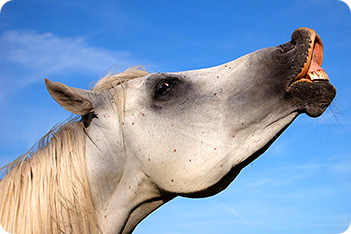
Equine Respiratory System
Vet, Horse First Aid
From: Horse Anatomy | Care

Respiratory System
This is the system that allows the horse to breath in oxygen that is essential for life and many body processes and exhale carbon dioxide which is a waste product.
Breathing Rate
This varies depending on climate, exercise, illness and excitement. A horse at rest will usually have a breathing rate of between 10 to 20 breaths in one minute, but this can vary with each individual. When the horse is exercising the breathing rate will go up considerably and for example when the horse is at a gallop it will breath in with every stride that it takes.
The Lungs
The lungs are situated within the Thoracic cavity and are aided by a muscle called the diaphragm which extends across the bottom of the rib cage and assists in expanding the lungs as well as separating the abdominal cavity from the thoracic cavity.
The Respiratory system uses the following to allow it to breath.
Nostrils
The horse has two nostrils which are held permanently open by rings of cartilage. As the horse inhales the air is warmed up and any debris such as dust particles are trapped.
Pharynx
The Pharynx is used for both Digestion and Respiration. It is the function of the soft palate to prevent food from entering the Trachea which it does by covering the entrance to the Oesophagus.
Glottis
This is the area between the vocal cords in the Larynx.
Larynx
The Larynx lies in between the Pharynx and the Trachea and has the purpose of preventing food from entering the Trachea, controlling the amount of air inhaled and it allows the horse to have a voice.
Trachea
This is a long tube that is held open by rings of cartilage that takes the air breathed in towards the lungs for diffusion. At the base, the Trachea splits into two branches called Bronchi.
Bronchi
The two main branches of the bronchi are the left and the right. The right bronchi splits up into a further three bronchioles and the left Bronchi splits up into two bronchioles.
Bronchioles
Each bronchiole then further subdivides into what are called Respiratory Bronchioles and it is at these that develop into Alveolar ducts. Each Respiratory Bronchiole can have between 2 and 10 Alveolar ducts.
Alveolar
Each Alveolar duct then becomes an Alveolar sac and it is through these that diffusion through the thin Alveolar sac wall takes place, this process allows oxygen to enter the bloodstream via the pulmonary vein and go directly to the heart and also allows for carbon dioxide to leave the blood stream via the pulmonary artery.
Disorders of the Respiratory system